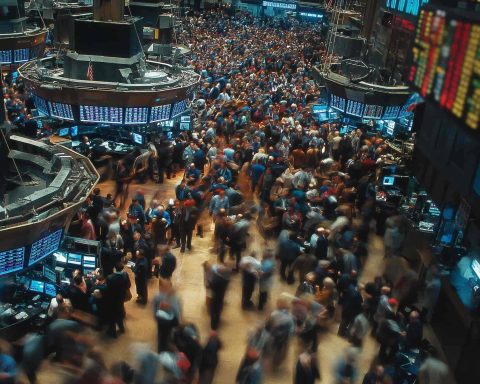Hong Kong’s stock market ended Thursday, 27 November 2025, essentially flat but still in the green, as optimism over imminent U.S. interest-rate cuts balanced fresh signs of China’s slowing industrial profits and renewed stress in the property and insurance sectors.
The Hang Seng Index closed at 25,945.93, up about 0.07% (17.85 points), marking a fourth straight session of gains and extending a roughly 2.8% rebound over the previous three days. It now sits just below the psychologically important 26,000 level. [1]
The Hang Seng China Enterprises Index finished almost unchanged at 9,164.87, while the Hang Seng Tech Index slipped 0.36% to 5,598.05, highlighting how money rotated into financials and select consumer names rather than broad-based tech. [2]
Key takeaways from today’s Hong Kong session
- Index: Hang Seng Index +0.07% to 25,945.93; fourth straight gain, hovering just under 26,000 resistance. [3]
- Macro push–pull: Bets on a U.S. Federal Reserve rate cut in December supported risk appetite, but China’s October industrial profits fell 5.5% year-on-year, softening the mood. [4]
- Sector moves: Financials and consumer names such as Pop Mart, Xiaomi and China Life advanced; tech and property stocks, including Alibaba and Longfor, lagged. [5]
- IPO spotlight: Online consumer platform Quantgroup (2685.HK)surged nearly 89% on debut, after one of the year’s most oversubscribed Hong Kong retail offerings. [6]
- Property strain: State-backed China Vanke fell close to 8% in Hong Kong after seeking to extend repayment on a 2 billion yuan onshore bond, deepening concern over China’s property crisis. [7]
- Local tragedy & insurance risk: A deadly fire at Tai Po’s Wang Fuk Court estate – Hong Kong’s worst in decades – left at least 55 dead and hundreds missing, and China Taiping Insurance shares swung after initial losses of around 8% on fears of large claims. [8]
Hang Seng edges higher, but momentum cools near 26,000
After opening slightly firmer, the Hang Seng spent much of the session hovering around the 26,000 mark before giving back most of its intraday gains and settling just below that threshold. [9]
Market data show the index has gained more than 710 points over the last three sessions – roughly 2.8% – putting it within touching distance of a key resistance zone around 26,000. Some technical commentary suggests that a decisive break above this area could open the way toward 27,000, while failure to clear it might see the index slide back toward 25,500, where short-term support and key moving averages converge. [10]
In contrast, turnover remained relatively muted with U.S. markets closed for the Thanksgiving holiday, keeping cross-border flows lighter than usual and encouraging traders to lock in short-term profits rather than place big directional bets. [11]
Fed rate-cut bets vs. China slowdown: the main tug-of-war
Globally, the tone for equities stayed constructive. Comments from Federal Reserve officials, including San Francisco Fed President Mary Daly and Governor Christopher Waller, have reinforced expectations that the U.S. central bank will cut rates at its December meeting. Futures pricing now implies roughly an 80–85% probability of a move, up from about 30% a week ago, according to CME FedWatch data cited in market reports. [12]
Lower U.S. rates typically:
- Weaken the U.S. dollar,
- Ease global financial conditions, and
- Make yield-sensitive Asian assets, like Hong Kong stocks, more attractive.
That macro backdrop has been one of the key drivers of the Hang Seng’s recent rebound.
But Thursday’s Chinese industrial profit figures served as a stark reminder that the real economy is still struggling. Official data show that industrial profits fell 5.5% year-on-year in October, snapping two months of strong double‑digit growth. Year-to-date profit growth slowed to 1.9% for January–October, down from 3.2% through September, with mining and related heavy sectors dragging on overall performance. [13]
Beijing has sought to counter this softness with more targeted, consumption‑oriented policies, including plans to boost spending on upgraded goods in rural areas and niche categories such as pets, anime and toys. [14] That theme would prove important for today’s biggest Hong Kong winners.
Consumer and financial shares lead modest gains
While the headline index barely moved, under the surface stock‑picking mattered a lot.
Pop Mart and other consumer names ride “new consumption” wave
Toy and collectibles maker Pop Mart International was among the standout performers, rallying roughly 6.8–7.1% to around HK$218–219. Local media and market summaries tied the move directly to Beijing’s latest “new consumption” push, which singles out categories like toys, pets and pop‑culture merchandise as areas for targeted support. [15]
Other gainers linked to consumer and healthcare themes included:
- Smoore International – up about 4.3%,
- Laopu Gold – up around 4.1%, and
- Akeso Inc. – up close to 3.8%,
underscoring investor appetite for stock-specific growth stories rather than broad sector bets. [16]
Financials help keep the index in positive territory
Market overviews highlighted that financial stocks did much of the heavy lifting for the benchmark. [17]
Among large caps:
- China Life Insurance rose roughly 2.2% to HK$27.32,
- Xiaomi climbed about 2.5% to HK$41.10, supported by optimism that lower global borrowing costs will sustain demand for hardware and services. [18]
The resilience of these names helped offset weakness in tech and property – the two sectors that continue to act as Hong Kong’s main drag.
Tech and property lag as Vanke weighs on sentiment
Despite the broader risk‑on tone, the Hang Seng Tech Index fell 0.36%, reflecting profit‑taking in heavyweight names and lingering scepticism after a rocky November for global tech. [19]
E‑commerce and platform giant Alibaba Group slipped a further 2.7% to HK$150.60, extending its post‑earnings pullback as investors reassessed growth expectations and regulatory risks. [20]
In property, selling pressure was more acute:
- Developer Longfor Group dropped about 3.7% to HK$9.75,
- While China Vanke – a bellwether for China’s embattled real estate sector – fell nearly 8% in Hong Kong, according to MT Newswires, after the company moved to seek bondholder approval to delay repayment on a 2 billion yuan onshore bond due 15 December. [21]
Reuters reported that this would be Vanke’s first public extension of an onshore bond, and that several of its yuan bonds slid more than 20–30% on Wednesday, with some trading in deeply distressed territory. [22]
The episode has reignited doubts over Beijing’s willingness to fully back even large, state‑linked developers, after a multi‑year property slump that has already seen defaults from high‑profile private groups. [23] For Hong Kong investors, that translated into renewed caution toward property stocks and highly leveraged balance sheets.
Quantgroup’s explosive IPO: small deal, big statement
The day’s most eye‑catching story came from the IPO market.
Shares of Quantgroup Holding Ltd. (2685.HK) – an online consumer‑platform operator – staged a spectacular debut:
- Offer price: HK$9.80 per share
- Opening trade: HK$26, up about 165% from the IPO price
- Intraday high/low: HK$27.8 / HK$18.3
- Closing price: HK$18.50, up about 88–89% on the day
- Volume: roughly 4.9 million shares traded, with turnover around HK$126.7 million
- Retail demand: the Hong Kong public tranche was oversubscribed more than 9,300 times, while the international book was about 14 times covered. [24]
In spite of the huge first‑day move, Quantgroup actually raised only about HK$131 million in gross proceeds, with most of that swallowed by listing expenses – leaving net proceeds of just over HK$12 million. [25]
Even so, the blowout oversubscription and strong aftermarket performance sends a signal that investors are still happy to back smaller, growth‑oriented consumer and internet names, especially when framed as plays on China’s shift from property‑driven growth toward consumption and digital platforms. [26]
By contrast, the slump in Vanke underlines how legacy, debt‑heavy sectors remain in the market’s penalty box.
Tai Po fire: tragedy, insurance shock and structural questions
Beyond the tickers, Hong Kong’s worst fire in decades cast a long shadow over Thursday’s trading.
A massive blaze at Wang Fuk Court, a large government‑linked housing estate in Tai Po, has killed at least 55 people and left nearly 300 residents missing or unaccounted for, according to evolving tallies from Hong Kong authorities cited by Reuters and other outlets. [27]
The fire, which tore through bamboo scaffolding and spread across multiple residential blocks during renovation works, has raised urgent questions about construction standards, materials and oversight. Police and regulators are investigating a construction contractor for alleged gross negligence and use of unsafe materials, with several arrests reported. [28]
China Taiping’s share-price whiplash
The disaster quickly spilled into the market via China Taiping Insurance Holdings (0966.HK):
- Public documents show China Taiping insures Wang Fuk Court, with coverage of up to HK$2 billion for damage to exterior and public areas.
- The company also reportedly insures the estate’s renovation project, with an “all‑risks” policy of around HK$365 million and employee compensation cover of HK$200 million. [29]
- On Thursday morning, its shares plunged as much as about 8–8.1% to roughly HK$16.77 before recovering much of the loss; by late morning they were closer to flat on the day, still underperforming the broader Hang Seng. [30]
While the precise financial hit for Taiping will only become clear once claims are processed, the market’s initial reaction underlined how idiosyncratic risks can suddenly dominate an individual stock, even on an otherwise quiet index day.
Longer-term implications for property and construction
Commentary from analysts and columnists suggests the disaster could force tighter safety rules, stricter inspection regimes and potentially higher compliance costs for developers and contractors, echoing how London’s Grenfell Tower fire reshaped regulations in the UK. [31]
For Hong Kong’s equity market, that adds another layer of uncertainty over a property sector already battling weak prices, heavy debt loads and policy overhangs.
How Hong Kong compares with the rest of Asia today
Hong Kong’s 0.1% rise was broadly in line with a cautiously positive session across Asia:
- Japan’s Nikkei 225 climbed about 1.2%,
- Shanghai Composite added around 0.3%,
- Other regional benchmarks such as South Korea’s Kospi and Australia’s S&P/ASX 200 also posted modest gains. [32]
Global coverage framed the session as an extension of Wall Street’s advance and European equities’ resilience, driven by the same theme: confidence that central banks, particularly the Fed, will keep policy supportive even as growth slows. [33]
In that context, Hong Kong looked like a “sleepy index, busy stock tape” kind of market: the benchmarks barely moved, but single‑stock volatility – from Quantgroup’s rocket‑like debut to Vanke and Taiping’s swings – was intense. [34]
What investors are watching next
Looking ahead, traders in Hong Kong will be focused on several key catalysts:
- December Fed meeting
- Markets are heavily priced for a rate cut next month; any shift in tone from U.S. data or Fed speakers could quickly reprice risk assets, including Hong Kong stocks. [35]
- China data flow and policy hints
- After October’s industrial profit contraction, investors will scrutinize upcoming figures on PMIs, retail sales and fixed‑asset investment, as well as any follow‑through from Beijing’s consumption‑boosting measures. [36]
- China Vanke bondholder meeting (10 December)
- The outcome of Vanke’s request to extend its 2 billion yuan bond could set a precedent for how other large, state‑linked developers handle their debts – and how tolerant authorities are of restructurings. [37]
- Regulatory and legal response to the Tai Po fire
- Any tightening of building, scaffolding or fire‑safety rules, or new guidance on insurance standards, will matter for developers, contractors and insurers listed in Hong Kong. [38]
From a market-structure perspective, the Hang Seng’s position just below 26,000 suggests near‑term direction may hinge on whether buyers have enough conviction to push through resistance, or whether profit‑taking and negative headlines around property and industrial data prompt another bout of risk‑off selling. [39]
For now, rate‑cut optimism, selective appetite for new economy and consumer names, and headline risk from property and local tragedies are all pulling the Hong Kong market in different directions – leaving the index little changed, even as big winners and losers emerge beneath the surface.
This article is for information and news-reporting purposes only and does not constitute investment advice. Always do your own research or consult a licensed financial adviser before making investment decisions.
References
1. english.news.cn, 2. english.news.cn, 3. english.news.cn, 4. www.reuters.com, 5. www.scmp.com, 6. www.aastocks.com, 7. www.reuters.com, 8. www.reuters.com, 9. www.businesstoday.com.my, 10. somoshermanos.mx, 11. www.indopremier.com, 12. www.reuters.com, 13. www.reuters.com, 14. www.reuters.com, 15. www.scmp.com, 16. www.indopremier.com, 17. www.indopremier.com, 18. www.scmp.com, 19. english.news.cn, 20. www.scmp.com, 21. www.indopremier.com, 22. www.reuters.com, 23. www.reuters.com, 24. www.aastocks.com, 25. thebambooworks.com, 26. thebambooworks.com, 27. www.reuters.com, 28. www.breakingviews.com, 29. www.reuters.com, 30. www.reuters.com, 31. www.breakingviews.com, 32. halifax.citynews.ca, 33. www.reuters.com, 34. finimize.com, 35. www.reuters.com, 36. www.reuters.com, 37. www.reuters.com, 38. www.breakingviews.com, 39. somoshermanos.mx










